Three years ago, a German pharmacology journal decided to stop admitting papers from China, having fallen prey to Chinese papermills. The chief editor then even issued a much acclaimed guideline on how to fight fraudulent submissions. But it didn’t work out: instead of fake Chinese papers, the journal now publishes fabrications from Egypt, Pakistan and Iran. It seems, without fake garbage papers from Asia, even a middle-tier journal would swiftly run out of papers to publish.
To be fair, many other allegedly respectable and academic-run journals became and even remain the garbage dumps of Chinese papermills. There are many explanation from qualified experts for this, but if you want mine: it’s due to publishers’ greed and editorial incompetence, or even individual crookedness.
But the case of Naunyn–Schmiedeberg’s Archives of Pharmacology (NSAP) is somewhat different. This Springer-published outlet is the official journal of the German Society of Experimental and Clinical Pharmacology and Toxicology (DGPT) and was founded in 1873. As its editors profess: “It is the oldest journal in this field of science.”
In February 2020, Smut Clyde found out that NSAP was massively infected with Chinese papermill fraud:
Dark Satanic Papermills
Smut Clyde investigates two more Chinese paper mills. One teamed up with an obscure Italian publisher, the other offers access to respectable society journals. How much of published and allegedly peer reviewed science is real?
I notified the NSAP Editor-in-Chief, the Hannover Medical School professor Roland Seifert, who swiftly replied. Seifert hinted to me on 27 February 2020 that in response to these papermill findings, his journal virtually stopped accepting papers from China. He then added this statement for publication, on how TCM quackery by Chinese papermills managed to infiltrate his journal:
“In the various excellent texts on paper mills the question is discussed why Naunyn-Schmiedebergs Archives of Pharmacology has become a target for fake papers. I oppose the assumption that we simply want to fill pages with pseudo-scientific content. We actually look for quality and good science. We do not look for perceived “impact” or “novelty”.
The journal has a long tradition of publishing papers in the field of phytopharmacology. […] The Chinese science policy to push TCM fits well to the scope of our journal. Therefore, we receive many papers from this field from China. In the past, we have received many papers on complex plant mixtures. Such papers are immediately rejected. However, many of the fake papers deal with pure active components of medical plants and fit to the scope of the journal. This focus […] renders our journal, most unfortunately, an attractive and “natural” target for fraudsters who want to “develop their careers”. ”
All the Chinese papermill forgeries on Smut Clyde’s list got retracted. Almost a year later, in February 2021, Seifert published this editorial, where he even acknowledged For Better Science in passing:
Seifert, R. How Naunyn-Schmiedeberg’s Archives of Pharmacology deals with fraudulent papers from paper mills. Naunyn-Schmiedeberg’s Arch Pharmacol (2021). doi: 10.1007/s00210-021-02056-8
The editorial had a 20-point list on how to spot fraudulent submissions, and new instructions for authors, including on sharing raw data. At NSAP, these new rules were declared as implemented since July 2020. In July 2021, NSAP brought a piece where an editorial board member, Marcel van der Heyden provided his expert advice on how to detect and prevent “publication fraud”.
van der Heyden, M.A.G. The 1-h fraud detection challenge. Naunyn-Schmiedeberg’s Arch Pharmacol (2021). doi: 10.1007/s00210-021-02120-3
I wrote about this strange editorial and other Papermill Heroes before, here:
Editors and other real papermill heroes
“Long story short, we investigated our published papers and then retracted those with data integrity issues. That is it.” – Dr Heather Smith, Editor-in-Chief
Taking stock almost 3 years after the papermill affair broke down over NSAP, how did the watchful journal fare without the Chinese fraud? Turns out, they had to do with Egyptian fraud. And other sources of trash science from Asia. We know that because a member of our sleuth team, a US-based female scientist under the pseudonym Dysdera arabisenen (a woodlice-hunting spider!) was on a prowl. She sent all her findings to Seifert, who announced to investigate together with the publisher Springer Nature.
Here is something Dysdera found in an NSAP paper accepted in March 2021, from the studio of Salman Khan, a prolific forger from Pakistan.
Ashraf Ullah Khan , Amna Khan , Adnan Khan , Bushra Shal , Abdul Aziz , Muhammad Naeem Ahmed , Salman Ul Islam , Hussain Ali , Adeeb Shehzad , Salman Khan Inhibition of NF-κB signaling and HSP70/HSP90 proteins by newly synthesized hydrazide derivatives in arthritis model Naunyn-Schmiedeberg s Archives of Pharmacology (2021) doi: 10.1007/s00210-021-02075-5

Salman Khan placed more papers in NSAP, possibly together with his extended family (several coauthors are also named Khan, which admittedly is a common last name in Pakistan). Here are two papers from 2022, both with poisoned mice:
Ashrafullah Khan , Adnan Khan , Bushra Shal , Abdul Aziz , Sajjad Ahmad , Muhammad Usman Amin , Muhammad Naeem Ahmed , Zia-ur-Rehman , Salman Khan Ameliorative effect of two structurally divergent hydrazide derivatives against DSS-induced colitis by targeting Nrf2 and NF-κB signaling in mice Naunyn-Schmiedeberg s Archives of Pharmacology (2022) doi: 10.1007/s00210-022-02272-w




Many partially recycled images. This time mice were poisoned and then treated with extracts from oranges:
Hadayat Ullah , Ashrafullah Khan , Tehmina Bibi , Sajjad Ahmad , Omer Shehzad , Hussain Ali , Eun Kyoung Seo , Salman Khan Comprehensive in vivo and in silico approaches to explore the hepatoprotective activity of poncirin against paracetamol toxicity Naunyn-Schmiedeberg s Archives of Pharmacology (2022) doi: 10.1007/s00210-021-02192-1

The Kahn gang with its around 40 papers on PubPeer, all flagged by Dysdera arabisenen, also polluted other journals, for example:
- Elsevier’s Life Sciences and Biomedicine & Pharmacotherapy, already overrun by Chinese papermills. The latter journal’s Editor-in-Chief Danyelle Townsend and Ethics Editor Kenneth Tew, both professors at the University of South Carolina in USA, even ignored retraction requests from investigators at Chinese universities. This is the kind of editorial crookedness I mentioned before.
- BMC Complementary Medicine and Therapies, because if you name a journal like that you make fraud your business model.
- Even the fancy ACS Nano, impact factor 18 (Qindeel et al 2020).
With the Pakistani Khan and the Egyptian crooks NSAP welcomed, it is not clear if they actually tortured mice for fun and then faked all results, or if they never had access to an actual lab and fabricated their papers out of thin air, in the way of a private papermill. In such a situation, one would really prefer a papermill explanation. We saw something similar with a Sicilian gang before:
The Fraud Squad
Either a Muslim colleague or a retired technician did it. Or so these Sicilian professors insist.
Of course, just because TCM and Chinese papermills are editorially banned, it doesn’t mean traditional medicine quackery wrapped in a fraudulent paper won’t find its way in. Here is an Egyptian gang of fraudsters, informing the scientific community of the amazing curative powers of licorice extract:
Sharifa Alzahrani , Sadeem M. Ajwah , Sumayyah Yasser Alsharif , Eman Said , Mohamed El-Sherbiny , Sawsan A. Zaitone , Mohamed Al-Shabrawey , Nehal M. Elsherbiny Isoliquiritigenin downregulates miR-195 and attenuates oxidative stress and inflammation in STZ-induced retinal injury Naunyn-Schmiedeberg s Archives of Pharmacology (2020) doi: 10.1007/s00210-020-01948-5


The panels A and C in Figures 2 and 5 are not just duplicated, they are both totally fraudulent and fake. Also, have a look at the Figure 8C (left), this kind of small in-image duplication generally happens when fraudsters need to remove original labellings from figures they stole elsewhere.
Like Khan , also these authors are serial fraudsters: the likely brothers Nehal and Mohamed Elsherbiny have many more fake papers on PubPeer, on licorice and nanoparticles.
Hence, meet another Egyptian named Elsherbiny, possibly a wife or a relative, extolling the curative powers of propolis and honey:
Aya A El-Demerdash , Esther T Menze , Ahmed Esmat , Mariane G Tadros , Doaa A Elsherbiny Protective and therapeutic effects of the flavonoid “pinocembrin” in indomethacin-induced acute gastric ulcer in rats: impact of anti-oxidant, anti-inflammatory, and anti-apoptotic mechanisms Naunyn-Schmiedeberg s Archives of Pharmacology (2021) doi: 10.1007/s00210-021-02067-5
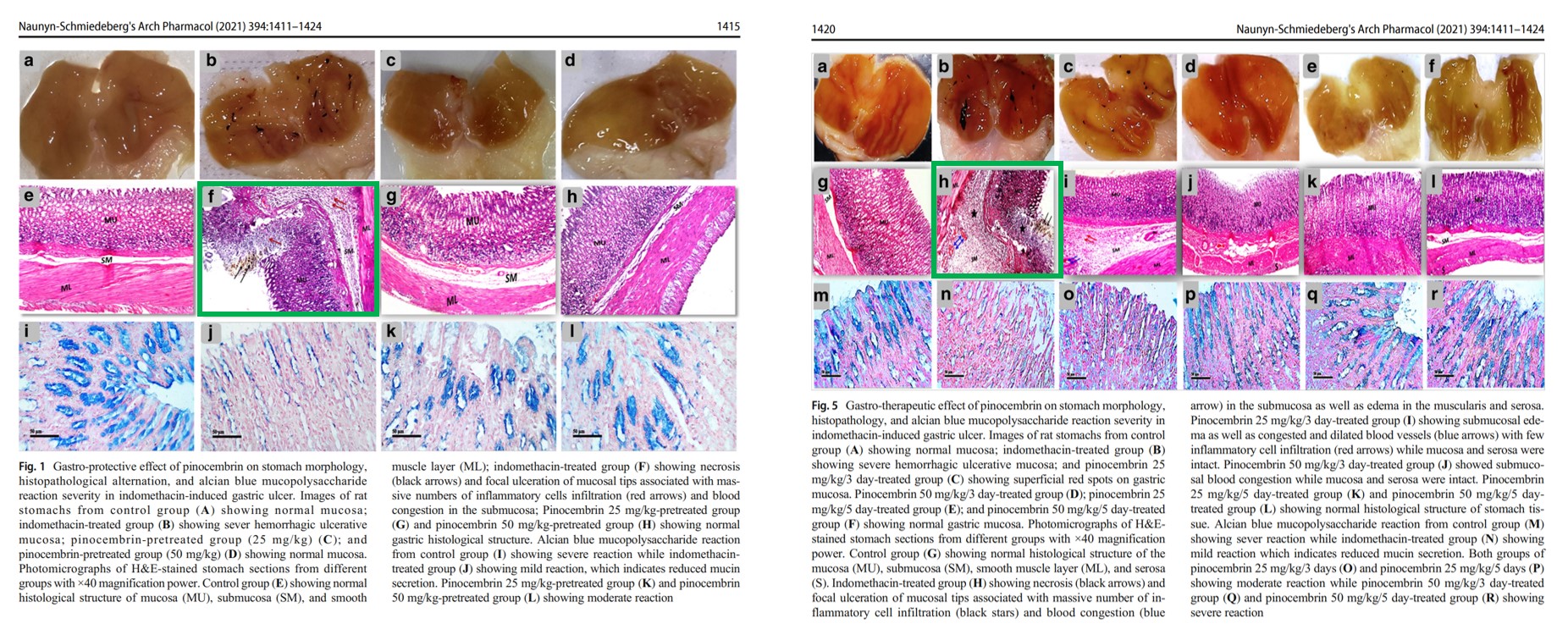
I guess Doaa Elsherbiny counted as a trusty author, because she published this in NSAP before:
Sara A Wahdan , Samar S Azab , Doaa A Elsherbiny , Ebtehal El-Demerdash Piceatannol protects against cisplatin nephrotoxicity via activation of Nrf2/HO-1 pathway and hindering NF-κB inflammatory cascade Naunyn-Schmiedeberg s Archives of Pharmacology (2019) doi: 10.1007/s00210-019-01673-8


Also from Egypt, with same Sara Wahdan you just met, she has currently 7 papers on PubPeer:
Noha M Mounier , Sara A Wahdan , Amany M Gad , Samar S Azab Role of inflammatory, oxidative, and ER stress signaling in the neuroprotective effect of atorvastatin against doxorubicin-induced cognitive impairment in rats Naunyn-Schmiedeberg s Archives of Pharmacology (2021) doi: 10.1007/s00210-021-02081-7
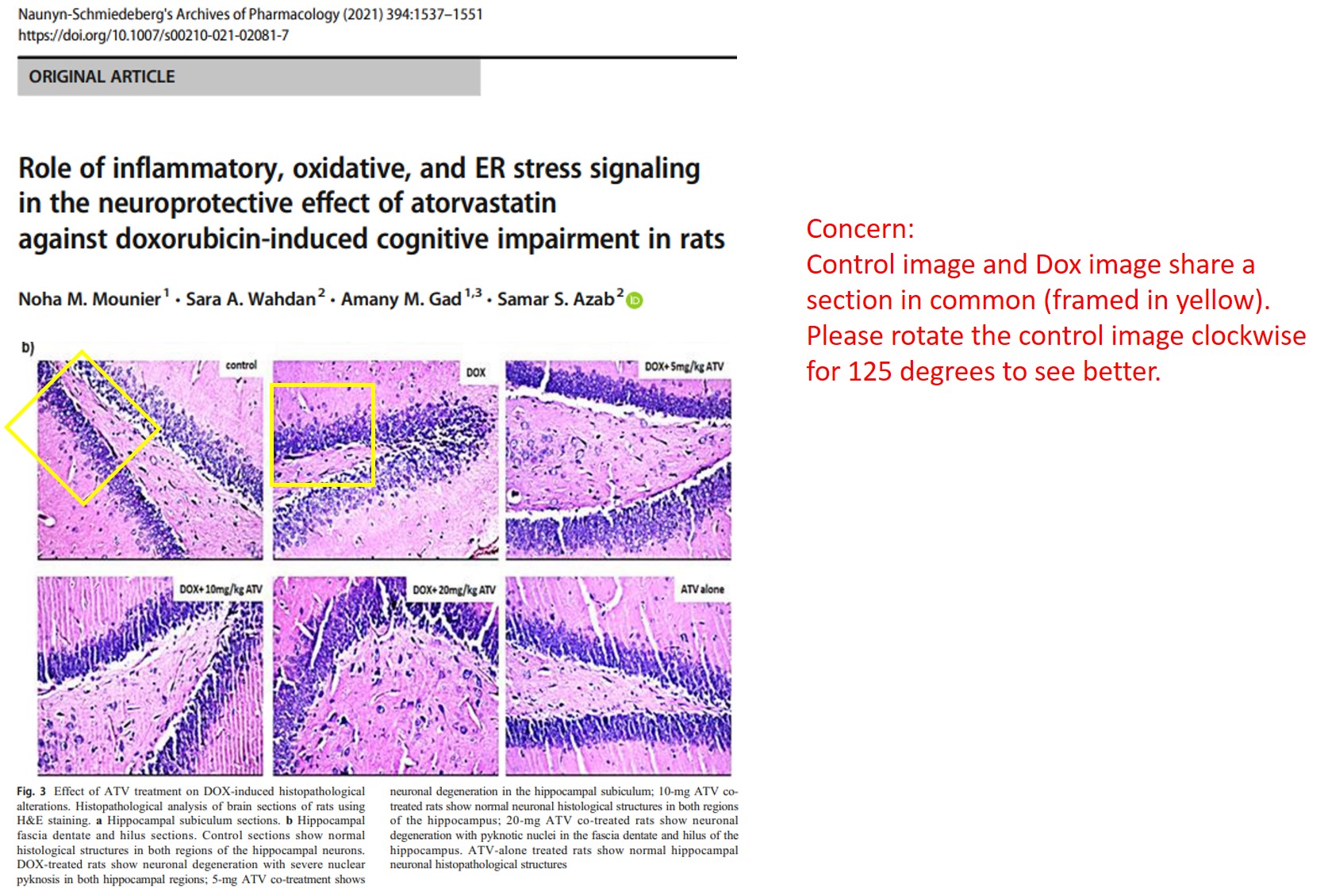
And here is an older NSAP paper jointly authored by Wahdan and Mariane Tadros (9 papers on PubPeer) whom you met separately in papers above:
Sara A. Wahdan , Mariane G. Tadros , Amani E. Khalifa Antioxidant and antiapoptotic actions of selegiline protect against 3-NP-induced neurotoxicity in rats Naunyn-Schmiedeberg s Archives of Pharmacology (2017) doi: 10.1007/s00210-017-1392-1


And another older paper by Tadros, obviously also a trusty contributor to NSAP:
Amr A. Elsayed , Esther T. Menze , Mariane G. Tadros , Bassant M. M. Ibrahim , Nagwa A. Sabri , Amani E. Khalifa Effects of genistein on pentylenetetrazole-induced behavioral and neurochemical deficits in ovariectomized rats Naunyn-Schmiedeberg s Archives of Pharmacology (2018) doi: 10.1007/s00210-017-1435-7

Here is another Egyptian trouble-maker:
Seham Abdel-Wekeel Abdel-Gaber , Medhat Atta , Sara Mohammed Naguib Abdel-Hafez , Walaa Yehia Abdelzaher Ameliorative effect of nicorandil in ovarian ischemia-reperfusion-induced injury in rats: role of potassium channel Naunyn-Schmiedeberg s Archives of Pharmacology (2020) doi: 10.1007/s00210-020-01854-w

In case you (or NSAP editors) might think this cloned cell a non-issue, have a look at an outrageously fake paper by the same Egyptian professor Walaa Yehia Abdelzaher: Abdelzaher et al 2021, in that American Journal of Papermill Fraud (Biomedicine & Pharmacotherapy) by Townsend & Elsevier.
Another Egyptian forgery:
Sara Mohamed Naguib Abdel Hafez , Entesar Ali Saber , Neven Makram Aziz , Maha Yehia Kamel , Ashraf A Aly , El-Shimaa M N Abdelhafez , Manar Fouli Gaber Ibrahim Potential protective effect of 3,3′-methylenebis(1-ethyl-4-hydroxyquinolin-2(1H)-one) against bleomycin-induced lung injury in male albino rat via modulation of Nrf2 pathway: biochemical, histological, and immunohistochemical study Naunyn-Schmiedeberg s Archives of Pharmacology (2022) doi: 10.1007/s00210-022-02324-1


More from Egypt, again published long after Seifert announced to crack down on fraudulent western blots (because these were what Smut Clyde focussed on at that time to find papermills):
Mahmoud E. Youssef, Heba M. Abdelrazek , Yasser M. Moustafa Cardioprotective role of GTS-21 by attenuating the TLR4/NF-κB pathway in streptozotocin-induced diabetic cardiomyopathy in rats Naunyn-Schmiedeberg s Archives of Pharmacology (2021) doi: 10.1007/s00210-020-01957-4



Nobody said anything about asking for raw data for immunohistochemistry images, so that’s what you get. Even more from Egypt:
Soad Z. El-Emam , Ayman A. Soubh , Asmaa K. Al-Mokaddem , Dina M. Abo El-Ella Geraniol activates Nrf-2/HO-1 signaling pathway mediating protection against oxidative stress-induced apoptosis in hepatic ischemia-reperfusion injury Naunyn-Schmiedeberg s Archives of Pharmacology (2020) doi: 10.1007/s00210-020-01887-1

There’s never enough fake immunohistochemistry from Egypt:
Amira Mohamed Abdelhamid , Shireen Sami Mahmoud , Aziza E Abdelrahman , Nelly Mohamed Said , Mostafa Toam , Walaa Samy , Marwa AbdEl-Moniem Amer Protective effect of cerium oxide nanoparticles on cisplatin and oxaliplatin primary toxicities in male albino rats Naunyn-Schmiedeberg s Archives of Pharmacology (2020) doi: 10.1007/s00210-020-01946-7

Were the editors and reviewers supposed to have spotted these duplications? Not always possible, but I think it is not even necessary to screen figures for irregularities to find a reason for rejection. These manuscripts are scientifically trash, as every half-way qualified expert in the field would have noticed by reading the abstract alone. But then again, NSAP needed papers to publish, and as long as it was not Chinese, rejection was not an option.
Maybe more from Egypt:
Mohammed E Abo-El Fetoh , Gouda K Helal , I G Saleh , M Ewees , Mohamed ElShafey , Mohamed R Elnagar , El-Sayed Akool Cyclosporin A activates human hepatocellular carcinoma (HepG2 cells) proliferation: implication of EGFR-mediated ERK1/2 signaling pathway Naunyn-Schmiedeberg s Archives of Pharmacology (2020) doi: 10.1007/s00210-019-01798-w


It’s really unfair the Chinese fraud got retracted and banned, but this from Egypt remained:
Ghada S El-Tanbouly , Mohammed S El-Awady, Nermeen A Megahed , Hassan A El-Kashef , Hatem A Salem The lipoxin A agonist BML-111 attenuates acute hepatic dysfunction induced by cecal ligation and puncture in rats Naunyn-Schmiedeberg s Archives of Pharmacology (2017) doi: 10.1007/s00210-016-1335-2


Maybe now it will be retracted. And Egyptian authors banned just like Chinese. But what will NSAP publish then?
Would you like to see something from Pakistan again?
Gagun Kamran , Hafiz Amir Ali Kharl , Muhammad Nasir Hayat Malik, Waqas Younis , Humaira Nadeem , Aymun Madni Zubair , Muhammad Atif Hayat Malik , Shah Jahan , Ishtiaq Ahmed , Ramla Shabbir , Asma Akram , Irfan Anjum , Muhammad Atif , Moosa Raza , Gull E Zahra Kamla Novel mannich-based derivative of 2-mercaptobenzimidazole (AK7): a new candidate for the treatment of inflammatory arthritis owing to its NF-κB1 inhibitory potential Naunyn-Schmiedeberg s Archives of Pharmacology (2022) doi: 10.1007/s00210-022-02359-4

One of the authors, Muhammad Nasir Hayat Malik, protested on PubPeer with:
- “According to our histopathologist Ishtiaq Ahmed, these were two different specimens.“
- “Moreover, there could be resemblance in hisological images as they are from same group and anatomical location is same.”
- “Well we have checked our repository files and in our records these slides belong to different specimens. But there could be a chance of mislabeling of slides and of course human errors are possible.[…] So overall results are the same”
Ban Pakistani also? Here is a forgery from Iran:
Davoud Sanajou , Saeed Nazari Soltan Ahmad , Vahid Hosseini , Ashkan Kalantary-Charvadeh , Yasser Marandi , Leila Roshangar , Saman Bahrambeigi , Mehran Mesgari-Abbasi β-Lapachone protects against doxorubicin-induced nephrotoxicity via NAD/AMPK/NF-kB in mice Naunyn-Schmiedeberg s Archives of Pharmacology (2019) doi: 10.1007/s00210-019-01619-0

How about Viagra-loaded nanoparticles, also from Iran?
Hamed Hajipour , Roshanak Sambrani , Marjan Ghorbani , Zahra Mirzamohammadi , Mohammad Nouri Sildenafil citrate–loaded targeted nanostructured lipid carrier enhances receptivity potential of endometrial cells via LIF and VEGF upregulation Naunyn-Schmiedeberg s Archives of Pharmacology (2021) doi: 10.1007/s00210-021-02153-8

Again, the small cloned patterns suggest that labellings from a stolen image had to be removed. That one was actually flagged by Orchestes quercus, another member of our team:
“Fig. 4b contains two highly similar regions. In one (green) case a rectangular region is simply translated and duplicated. In the other (red) case a region is duplicated after 180° rotation.“
To conclude the exhibition, here is an Egyptian paper where one can really only pray that it was entirely made-up, without any actual lab experiments. Obviously the editors and reviewers did not mind the horrendous torture mice were allegedly subjected to. It was flagged by yet another member of our team):
Alaa E. El-Sisi , Samia S. Sokar , Hanaa A. Ibrahim , Sally E. Abu-Risha Enhanced anticancer activity of combined treatment of imatinib and dipyridamole in solid Ehrlich carcinoma-bearing mice Naunyn-Schmiedeberg s Archives of Pharmacology (2020) doi: 10.1007/s00210-019-01803-2

In this study there is apparently no limit in tumor volume. Figure 3 show tumor volumes up to 5000 mm3. I am surprised that any European journals will accept this kind of studies.
In Figure 4, an overview of survivial is shown. Did the mice die from the tumor growth or were they euthanized? Since there is no apparent limit on tumor volume, what was the criteria for when mice were euthanized? Extreme suffering?“
It is quite obvious that even at the German-run NSAP no editor or peer reviewer is actually reading the submissions, just checking if they comply to a certain model of what a research paper should look like. A model originally established by western fraudsters in elite journals, which by now generations of editors and scientists have been trained on. And which papermills understood like no other.
And then the editors act surprised and shocked that their journal is full of Asian fraud. And announce a massive crackdown. On what, their entire publishing model?
The full-service paper mill and its Chinese customers
An investigation by Elisabeth Bik, Smut Clyde, Morty and Tiger BB8 reveals the workings of a paper mill. Its customers are Chinese doctors desperate for promotion. Apparently even journal editors are part of the scam, publishing fraudulent made-up science.
Previously I wrote about another editorial Seifert issued, in September 2021:
Bernhard A. Sabel & Roland Seifert How criminal science publishing gangs damage the genesis of knowledge and technology—a call to action to restore trust Naunyn-Schmiedeberg’s Archives of Pharmacology (2021) doi: 10.1007/s00210-021-02158-3
In this masterpiece of academic wisdom and modesty, the authors decided to rename paper mills to “Criminal science publishing gangs“. It ends with:
“The time to show courage and take action to regain the trust we all deserve is now!
What do science and “true love” have in common? Both are infatuated by passion, but if trust is lost, it is almost impossible to go back.”
The references go to the usual: Jennifer Byrne & Jana Christopher, van der Heyden, a Nature article about our papermill investigations, and for some reason to “Sabel BA (1993) Science reunification in Germany – “a crash program.”. Exactly ZERO mention goes to For Better Science and my colleagues Smut Clyde, Tiger BB8 and others.
Who is this Bernhard Sabel character, you might wonder? He is not on editorial board, luckily. This German psychology professor at the University of Magdeburg has a ridiculously hagiographic Wikipedia page, in English, German, Italian, Chinese and Russian. He also cured two women of COVID-19 after-effects on the brain, with electrical currents (Sabel et al 2021).
Tiwari’s IAAM honours Magdeburg
Ashutosh Tiwari’s scamference activities continue. Now the University of Magdeburg in Germany is very excited about a medal from the International Association of Advanced Materials.
In the summer of 2022 our Hero of Papermills, pardon, Hero of Criminal Science Publishing Gangs, set up a Science Integrity Alliance, or SIA for short. Sabel sent out a letter inviting people to join, excerpt:
“The SIA mission is not to follow individual cases of science fraud, manipulation of experiments, statistical nudging, plagiarism etc. We want to learn more about – and fight – fake science publishing itself. The more people participate in this effort (scientists, publishers, administration, politics), the greater the probability of finding means to stop this knowledge pollution and get things in order again.”
I suspect even Seifert never joined, in any case the mighty Alliance by now probably consists of Sabel as its only half-way active member. Maybe SIA’s whole purpose was to make that Magdeburg narcissist a President of something. If you wondered: I digressed into the Sabel story to show you what kind of people the NSAP chief editor Seifert respects and writes thundering editorials about papermills with. As opposed to actual papermill sleuths whose interviews he cancels.
The Chinese Paper Mill Industry: Interview with Smut Clyde and Tiger BB8
Unlike those fake paper mill products, this interview failed editorial review and journal quality control.
I shall end with another NSAP editorial, the most recent one on the topic:
Dats, L.B., von Haugwitz, F. & Seifert, R. Bibliometric development of Naunyn–Schmiedeberg’s Archives of Pharmacology. Naunyn-Schmiedeberg’s Arch Pharmacol (2023). 10.1007/s00210-022-02307-2
It discusses the geographic origin of NSAP papers:
“We could see a decrease in publications from Germany and an increase in papers from Brazil, China, Egypt, and Iran during the last years. The decrease in publications from Germany is probably a zeitgeist effect because this country places a strong emphasis on high-impact factor papers for academic promotion and winning grants. Germany was the country with the most publications throughout the 100 most-cited articles. Most of these articles were published between 1970 and 1990, when neurotransmitters were the most published topic.”
And these days Germans avoid NSAP due to its modest impact factor, as the editors lament. Well, I am sorry, it’s true, yes, European and American quality fraud goes into Cell and Nature family journals, not NSAP. Lower-ranking journals are left with trashy fraud and papermills from China, India, Pakistan, Iran, Egypt and other Arab countries, which is actually the entire thriving business model of MDPI and Hindawi. I wonder if all journals, big and small, keep rejecting the non-fake actual science because it doesn’t look like the standartised, often fraudulent garbage, which the system has been trained on for decades. You know, with an elegant molecular mechanistic insights offering a simple cure for a complex disease, with all the buzzwords checked.
The recent NSAP editorial however doesn’t mention papermills or fraud, I guess this chapter is closed and they moved on. You saw above what Egypt supplied NSAP with after Chinese submissions got banned, so maybe the chapter is worth re-opening. Bring Sabel back, I say! Have van der Heyden issue another guideline!

I thank all my donors for supporting my journalism. You can be one of them!
Make a one-time donation:
I thank all my donors for supporting my journalism. You can be one of them!
Make a monthly donation:
Choose an amount
Or enter a custom amount
Your contribution is appreciated.
Your contribution is appreciated.
DonateDonate monthly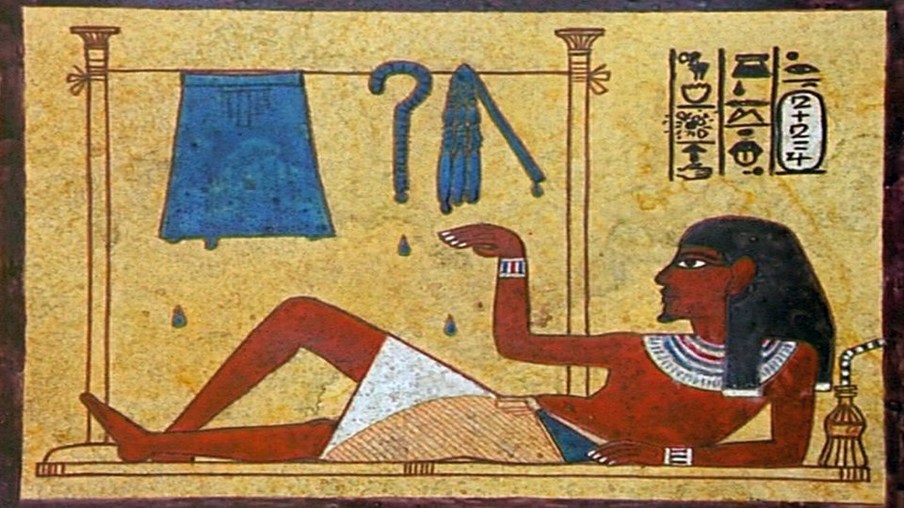



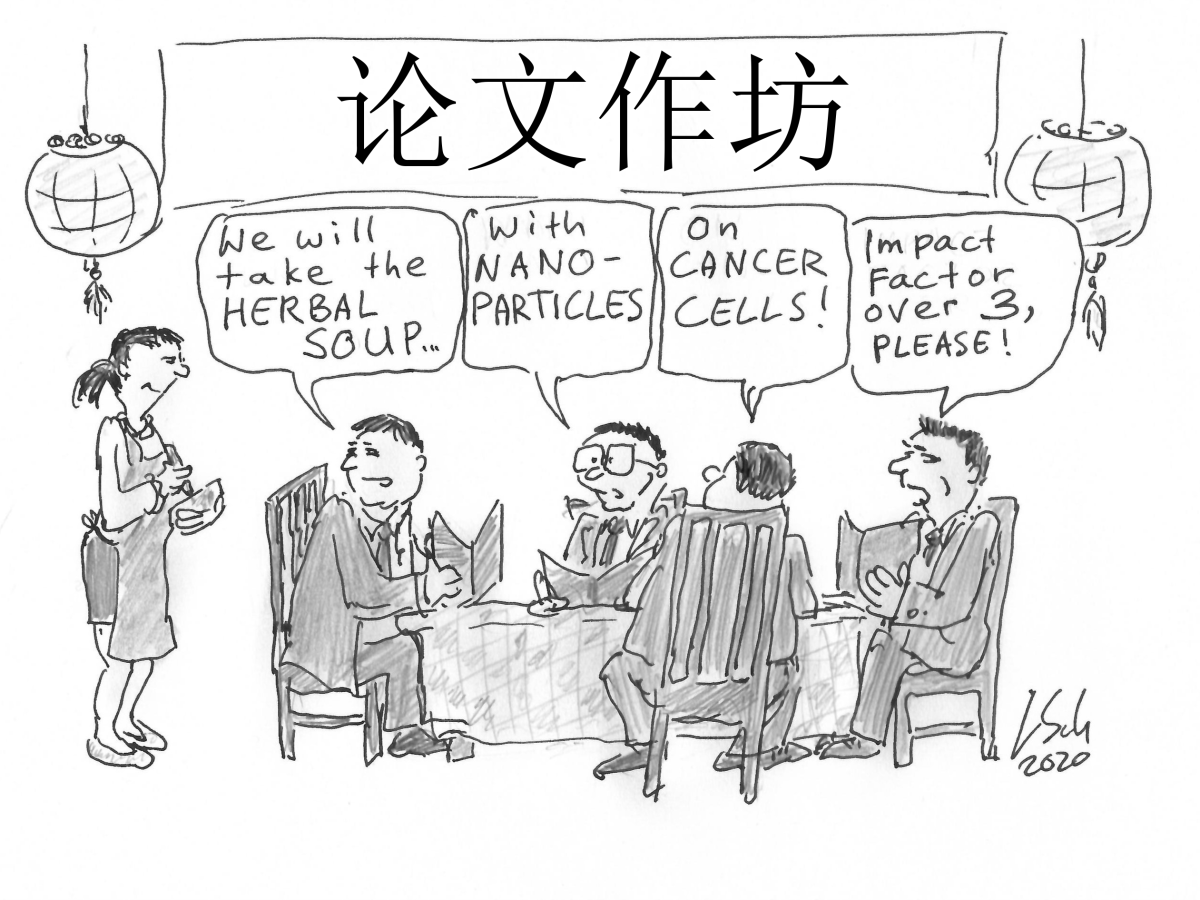
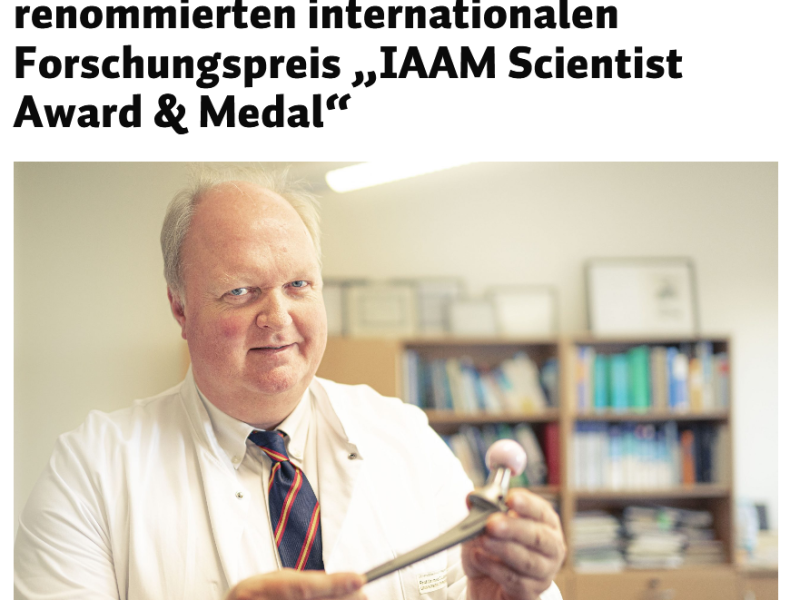
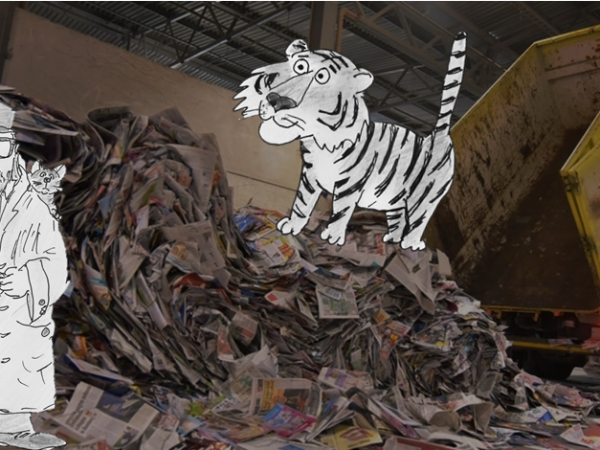

Eh, this guy, Seifert, is really brilliant. He closes the door to the Chinese and opens it wide to everyone else. Then one wonders how scammers get every smut accepted. And we’re talking about a big German professor, big deal!. There are no words.
LikeLike
“Acknowledgments The authors declare that all data were generated in-
house and that no paper mill was used.”
“Data availability Not applicable”
(Özakman, S., Gören, M. Z., Nurten, A., Tekin, N., Kalaycı, R., & Enginar, N. (2020). Effects of tamoxifen and glutamate and glutamine levels in brain regions in repeated sleep deprivation–induced mania model in mice. Naunyn-Schmiedeberg’s Archives of Pharmacology, 394(4), 619–629. doi:10.1007/s00210-020-02001-1 )
LikeLike
Ah but they are not Chinese!
LikeLike